What’s better than reading a good book? Having a friend to whom you can recommend it as a good read. We have worked together on reviewing books for close to a decade and over that period have recommended to each other many engaging, challenging, and thought-provoking books. Here are some of our recently shared books, books to provide readers pleasure and insight into unexpected experiences.
Ages 4–8
Maybe Something Beautiful: How Art Transformed a Neighborhood. F. Isabel Campoy & Theresa Howell. Ill. Rafael López. 2016. Houghton Mifflin Harcourt.
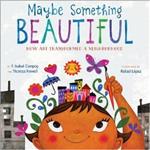 When young Mira gives her colorful drawings of an apple, a flower, a bird, and a heart to people she meets on the street, she spreads a little joy. Inspired by Mira’s picture of the sun that she has taped to a grey wall, a man with a pocket full of paintbrushes, who identifies himself to her as a muralist, begins to spread color throughout the streets. Mira joins him and soon they are passing out brushes to others. Working together people transform their drab neighborhood into something beautiful and joyful. A note from the authors provides background for the book that was inspired by the work of Rafael López, an artist (and creator of the illustrations for Maybe Something Beautiful), and his wife, Candace, a graphic designer, who transformed the East Village near downtown San Diego, CA, into a colorful community.
When young Mira gives her colorful drawings of an apple, a flower, a bird, and a heart to people she meets on the street, she spreads a little joy. Inspired by Mira’s picture of the sun that she has taped to a grey wall, a man with a pocket full of paintbrushes, who identifies himself to her as a muralist, begins to spread color throughout the streets. Mira joins him and soon they are passing out brushes to others. Working together people transform their drab neighborhood into something beautiful and joyful. A note from the authors provides background for the book that was inspired by the work of Rafael López, an artist (and creator of the illustrations for Maybe Something Beautiful), and his wife, Candace, a graphic designer, who transformed the East Village near downtown San Diego, CA, into a colorful community.
—CA
This Is Not a Picture Book! Sergio Ruzzier. 2016. Chronicle.
 A duckling is thrilled when he finds a book and then disdainful and disappointed when he finds no pictures in it. In a moment of remorse at his outburst, he looks into it again. A bug asks him whether he can read the book with no pictures. Ruzzier’s illustrations, rendered in pen and ink and watercolor, show the duckling and bug crossing over into a world filled with words (pictured as odd shaped, unidentifiable objects). He begins to recognize a few words such as flower, bee, and clouds. With growing excitement, he discovers that words not only take him on a journey and then return him home again but also stay with him forever. Young children just beginning to explore the world of reading will find fun, sympathy, and comfort in the story of the little duckling. Adding content to the book, the front endpapers are filled with lines of mostly indecipherable words while the back endpapers have a readable text, a story about a little duckling discovering the power of reading.
A duckling is thrilled when he finds a book and then disdainful and disappointed when he finds no pictures in it. In a moment of remorse at his outburst, he looks into it again. A bug asks him whether he can read the book with no pictures. Ruzzier’s illustrations, rendered in pen and ink and watercolor, show the duckling and bug crossing over into a world filled with words (pictured as odd shaped, unidentifiable objects). He begins to recognize a few words such as flower, bee, and clouds. With growing excitement, he discovers that words not only take him on a journey and then return him home again but also stay with him forever. Young children just beginning to explore the world of reading will find fun, sympathy, and comfort in the story of the little duckling. Adding content to the book, the front endpapers are filled with lines of mostly indecipherable words while the back endpapers have a readable text, a story about a little duckling discovering the power of reading.
—SW
The Wildest Race Ever: The Story of the 1904 Olympic Marathon. Meghan McCarthy. 2016. Simon & Schuster.
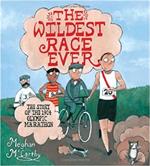 McCarthy’s story of the first Olympic marathon held in America, which took place at the 1904 World’s Fair in St. Louis, will leave readers marveling over the contrast of this incredibly wacky race with marathon running today. McCarthy uses an abundance of direct quotes from newspaper reports of the race run by 32 competitors from six countries over a hilly, dirt road route in 90-degree heat. Her cartoon-like double spreads, featuring the motley bunch of runners with googly eyes and lopsided grins, highlight some peculiar events such as South African Len Tau being chased a mile off course by a dog; Cuban Felix Carvajal stopping to chat with spectators to practice his English; and Fred Lorz, overcome with cramps at mile 9, riding in an automobile, but then running again near the finish line and coming in first (he was disqualified for cheating). Back matter includes notes on the marathon runners and the 1904 World’s Fair and a bibliography. The endpapers picture postcards of the fair with handwritten messages.
McCarthy’s story of the first Olympic marathon held in America, which took place at the 1904 World’s Fair in St. Louis, will leave readers marveling over the contrast of this incredibly wacky race with marathon running today. McCarthy uses an abundance of direct quotes from newspaper reports of the race run by 32 competitors from six countries over a hilly, dirt road route in 90-degree heat. Her cartoon-like double spreads, featuring the motley bunch of runners with googly eyes and lopsided grins, highlight some peculiar events such as South African Len Tau being chased a mile off course by a dog; Cuban Felix Carvajal stopping to chat with spectators to practice his English; and Fred Lorz, overcome with cramps at mile 9, riding in an automobile, but then running again near the finish line and coming in first (he was disqualified for cheating). Back matter includes notes on the marathon runners and the 1904 World’s Fair and a bibliography. The endpapers picture postcards of the fair with handwritten messages.
—CA
Ages 9–11
The Big Dark. Rodman Philbrick. 2016. Blue Sky/Scholastic.
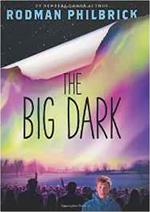 As Charlie Cobb watches a northern lights display along with most of the other residents of the small town of Harmony, NH, on New Year’s Eve, a brilliant solar flare flashes across the sky. Immediately, all is dark:Lights go out and even battery-operated flashlights and cars fail. Nothing electrical works. Used to outages in inclement weather, no one is too concerned until days go by without a restoration of power. Science teacher Mr. Mangano identifies the problem as Geomagnetic Interference (GMI), a massive disruption of the Earth’s magnetic field. The town’s part-time policeman and school janitor, Mr. Kingman, organizes a community survival plan that works for a time. Racist, anti-government Webster Bragg, who lives in a compound on the edge of town, burns the only local grocery and pharmacy and takes control of resources at gunpoint, declaring himself leader of the new town of Liberty. It is young Charlie’s incredibly dangerous trek down the mountain to Concord in search of medicine for his diabetic mother that young readers will find most compelling. Charlie overcomes the dangers of skiing and snowshoeing in extreme weather, encounters with wild animals, and the unexpected hostility toward strangers to become a local hero, with the help of a few caring individuals.
As Charlie Cobb watches a northern lights display along with most of the other residents of the small town of Harmony, NH, on New Year’s Eve, a brilliant solar flare flashes across the sky. Immediately, all is dark:Lights go out and even battery-operated flashlights and cars fail. Nothing electrical works. Used to outages in inclement weather, no one is too concerned until days go by without a restoration of power. Science teacher Mr. Mangano identifies the problem as Geomagnetic Interference (GMI), a massive disruption of the Earth’s magnetic field. The town’s part-time policeman and school janitor, Mr. Kingman, organizes a community survival plan that works for a time. Racist, anti-government Webster Bragg, who lives in a compound on the edge of town, burns the only local grocery and pharmacy and takes control of resources at gunpoint, declaring himself leader of the new town of Liberty. It is young Charlie’s incredibly dangerous trek down the mountain to Concord in search of medicine for his diabetic mother that young readers will find most compelling. Charlie overcomes the dangers of skiing and snowshoeing in extreme weather, encounters with wild animals, and the unexpected hostility toward strangers to become a local hero, with the help of a few caring individuals.
—CA
Far From Fair. Elena K. Arnold. 2016. Houghton Mifflin Harcourt.
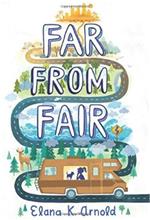 Odette is disappointed that her parents have sold their house and bought an RV, which her mother calls the Coach, in preparation for a road trip to Orcas Island, off the coast of Washington, to take care of Grandma Sissy, who has cancer. The family’s downsizing means they have one cell phone, no privacy, and only the possessions that will fit in the Coach. Odette feels a growing loss. In a moment of sympathy, her father brings her a dog, only it is not the sleek Labrador puppy with soft, silky ears of her dreams, but a full-grown, ratty little black dog. Even with Odette’s parents considering a divorce and her brother, Rex, prone to exhausting tantrums, the family leaves Southern California, camping along the way north. Grandma Sissy encourages Odette to have fun on Orcas Island telling her, “Sometimes we are powerless over what life gives us. But we have power over what we are given.” Odette’s list of all that is not fair grows before she discovers how she can make what she is given work.
Odette is disappointed that her parents have sold their house and bought an RV, which her mother calls the Coach, in preparation for a road trip to Orcas Island, off the coast of Washington, to take care of Grandma Sissy, who has cancer. The family’s downsizing means they have one cell phone, no privacy, and only the possessions that will fit in the Coach. Odette feels a growing loss. In a moment of sympathy, her father brings her a dog, only it is not the sleek Labrador puppy with soft, silky ears of her dreams, but a full-grown, ratty little black dog. Even with Odette’s parents considering a divorce and her brother, Rex, prone to exhausting tantrums, the family leaves Southern California, camping along the way north. Grandma Sissy encourages Odette to have fun on Orcas Island telling her, “Sometimes we are powerless over what life gives us. But we have power over what we are given.” Odette’s list of all that is not fair grows before she discovers how she can make what she is given work.
—SW
Pax. Sara Pennypacker. Ill. Jon Klassen. 2016. HarperCollins.
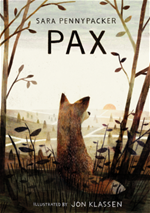 Pax, an abandoned fox, has been motherless Peter’s constant companion for five years. Now 12-year-old Peter is being sent to live with his grandfather. His father, who is going off to war, insists that Pax be released in the wild. The story is told from the points of view of Peter and Pax in alternate chapters: Peter immediately realizes the wrongness of the separation; Pax doesn’t understand his abandonment. Against the background of an all-to-close war, boy and fox have encounters that change them. Pax learns survival skills from Bristle, a vixen, and her brother, Runt. Peter, who injures his foot in his hurry to make progress on the 300-mile trip back to where they left Pax, is sheltered by Vola, a hermit and veteran with PTSD. She sets his broken bones, makes him crutches, and puts him on a rigorous training program so that he can resume his trip, while also helping him understand that his reunion with Pax may not be in Pax’s best interest, even if it is possible. Pax is a beautiful, moving story of the love and loyalty of a relationship between a wild animal and a boy.
Pax, an abandoned fox, has been motherless Peter’s constant companion for five years. Now 12-year-old Peter is being sent to live with his grandfather. His father, who is going off to war, insists that Pax be released in the wild. The story is told from the points of view of Peter and Pax in alternate chapters: Peter immediately realizes the wrongness of the separation; Pax doesn’t understand his abandonment. Against the background of an all-to-close war, boy and fox have encounters that change them. Pax learns survival skills from Bristle, a vixen, and her brother, Runt. Peter, who injures his foot in his hurry to make progress on the 300-mile trip back to where they left Pax, is sheltered by Vola, a hermit and veteran with PTSD. She sets his broken bones, makes him crutches, and puts him on a rigorous training program so that he can resume his trip, while also helping him understand that his reunion with Pax may not be in Pax’s best interest, even if it is possible. Pax is a beautiful, moving story of the love and loyalty of a relationship between a wild animal and a boy.
—CA
Ages 12–14
Hour of the Bees. Lindsay Eagar. 2016. Candlewick.
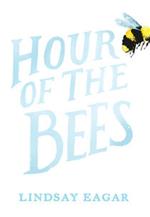 Carol, her parents, and toddler brother are spending the summer at her grandfather’s ranch in the desert of Southern Arizona to take care of him as his dementia progresses. When they arrive, they find the grandfather sitting on the porch, much-aged, tubes from an oxygen tank feeding into his nose. The dog, Inez, welcomes the family, but Carol’s father, Raul, is as incredulous that the dog from his youth would be alive as he is surprised at the dried-out condition of the ranch. Her grandfather (who insists on pronouncing her full name, Carolina, as Carol-leena, telling her she has a beautiful name) tells her a story of life of the ranch. His fantastic stories about the village, lake, the measure of time, the life-giving tree, and Rosa, his wife and Raul’s mother, become more believable when Carolina discovers a closet of treasures from around the world that Rosa had collected in her travels. Her grandfather’s insistence that the bees will bring the rain have increasing credibility for Carolina even after her parents sell the ranch and place Grandfather in an assisted living community. As her grandfather’s stories unfold and Raul comes to understand what happened to his mother, Carolina makes decisions that affect all of them.
Carol, her parents, and toddler brother are spending the summer at her grandfather’s ranch in the desert of Southern Arizona to take care of him as his dementia progresses. When they arrive, they find the grandfather sitting on the porch, much-aged, tubes from an oxygen tank feeding into his nose. The dog, Inez, welcomes the family, but Carol’s father, Raul, is as incredulous that the dog from his youth would be alive as he is surprised at the dried-out condition of the ranch. Her grandfather (who insists on pronouncing her full name, Carolina, as Carol-leena, telling her she has a beautiful name) tells her a story of life of the ranch. His fantastic stories about the village, lake, the measure of time, the life-giving tree, and Rosa, his wife and Raul’s mother, become more believable when Carolina discovers a closet of treasures from around the world that Rosa had collected in her travels. Her grandfather’s insistence that the bees will bring the rain have increasing credibility for Carolina even after her parents sell the ranch and place Grandfather in an assisted living community. As her grandfather’s stories unfold and Raul comes to understand what happened to his mother, Carolina makes decisions that affect all of them.
—SW
The Smell of Other People’s Houses. Bonnie-Sue Hitchcock. 2016. Wendy Lamb/Random House.
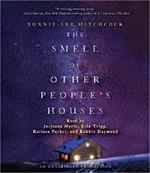 Four Alaskan teens tell their individual stories about events that take place over spring and summer, although one of the stories starts before then in a prologue that tells of the death of the father of one of them, Ruth, not long before Alaska became a state. Ruth’s story takes her to an abbey in the Yukon, where she learns about the life of her grandmother, with whom she lives, who grew up there among the nuns. Another narrator, Alyce, living in Fairbanks, longs to be a dancer but is eager to help her fisherman father and uncle. A third narrator, Hank, and his two brothers, whose father, a fisherman, was lost at sea, leave their mother and stow away on a ferry bound for Prince Rupert. A fourth narrator, Dora, an Athabascan girl, lives with a family in Fairbanks, and becomes involved with Ruth’s family. While the teens search for a way to make their lives better, they discover that family is also those people they love and who love them. The narrators, in recounting past experiences that have shaped them and their lives, discover that they sometimes need to hold on to whatever they can.
Four Alaskan teens tell their individual stories about events that take place over spring and summer, although one of the stories starts before then in a prologue that tells of the death of the father of one of them, Ruth, not long before Alaska became a state. Ruth’s story takes her to an abbey in the Yukon, where she learns about the life of her grandmother, with whom she lives, who grew up there among the nuns. Another narrator, Alyce, living in Fairbanks, longs to be a dancer but is eager to help her fisherman father and uncle. A third narrator, Hank, and his two brothers, whose father, a fisherman, was lost at sea, leave their mother and stow away on a ferry bound for Prince Rupert. A fourth narrator, Dora, an Athabascan girl, lives with a family in Fairbanks, and becomes involved with Ruth’s family. While the teens search for a way to make their lives better, they discover that family is also those people they love and who love them. The narrators, in recounting past experiences that have shaped them and their lives, discover that they sometimes need to hold on to whatever they can.
—SW
Ages 15+
The Memory of Light. Francisco X. Stork. 2016. Arthur A. Levine/Scholastic.
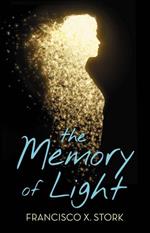 Sixteen-year-old Vicky Cruz wakes up in the psychiatric ward of Lakeview, a public hospital, after a failed suicide attempt. Working with her therapist, Dr. Desai, and getting to know Mona, Gabriel, and E.M., the three other teens in her therapy group, Vicky realizes she needs to stay longer in this supportive environment. Her father and stepmother, however, feel she must come home and get back to a normal routine if she is to have a future (as in getting into a top-tier college like her sister did). Stork tells the powerful and realistic story of Vicky’s movement from the darkness of her clinical depression, in which she felt alone and without a reason to live, to recovery to the point that she can return home with the strength to live if she has some control over what that life will be. In his author’s note Stork talks about his own suicide attempt and living with depression. He says he hopes that Vicky’s story will make it easier for young people to recognize depression in themselves and others and to talk about it.
Sixteen-year-old Vicky Cruz wakes up in the psychiatric ward of Lakeview, a public hospital, after a failed suicide attempt. Working with her therapist, Dr. Desai, and getting to know Mona, Gabriel, and E.M., the three other teens in her therapy group, Vicky realizes she needs to stay longer in this supportive environment. Her father and stepmother, however, feel she must come home and get back to a normal routine if she is to have a future (as in getting into a top-tier college like her sister did). Stork tells the powerful and realistic story of Vicky’s movement from the darkness of her clinical depression, in which she felt alone and without a reason to live, to recovery to the point that she can return home with the strength to live if she has some control over what that life will be. In his author’s note Stork talks about his own suicide attempt and living with depression. He says he hopes that Vicky’s story will make it easier for young people to recognize depression in themselves and others and to talk about it.
—CA
Sandip Wilson serves as associate professor in the College of Health and Education of Husson University in Bangor, ME. Carolyn Angus is former director of the George G. Stone Center for Children's Books, Claremont Graduate University, CA. They worked together as editors of the Children’s Literature and Reading SIG’s journal, The Dragon Lode, from 2008 to 2014.
These reviews are submitted by members of the International Literacy Association's Children's Literature and Reading Special Interest Group (CL/R SIG) and are published weekly on Literacy Daily.